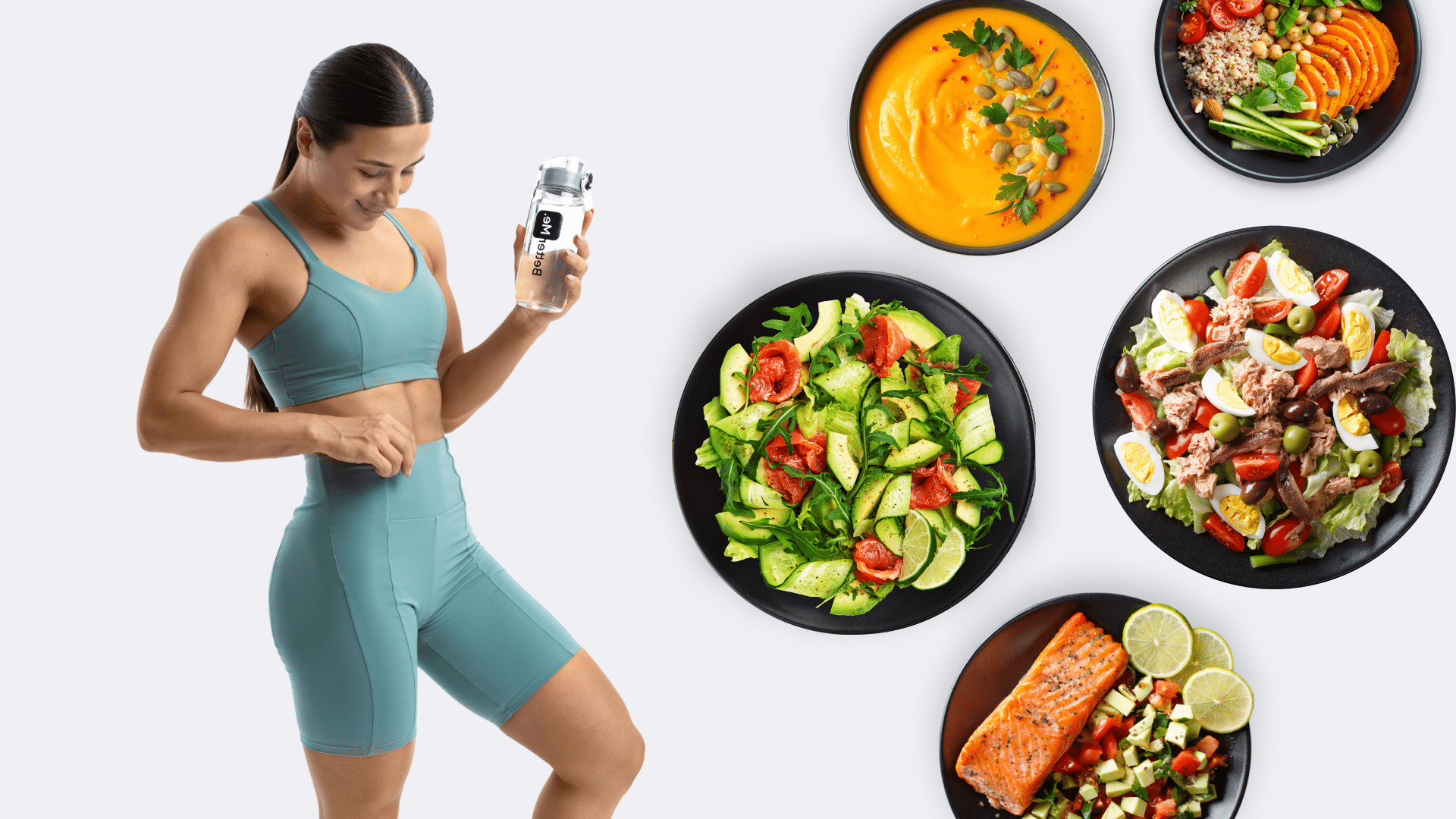What you eat during your eating window when you’re on a 16/8 intermittent fasting schedule is just as important as the fast itself.
The right meals will nourish your body while also keeping hunger at bay, supporting weight loss, and enhancing your overall health benefits.
At the same time, poorly chosen foods can sabotage your fasting efforts, which will lead to feelings of deprivation and fatigue and even result in malnutrition over time. You may even end up overeating during your eating window, which will negate any potential benefits of the fast.
So what meals should you incorporate into your 16/8 intermittent fasting plan to maximize its effectiveness? Here’s everything you need to know about preparing nutritious and satisfying meals that align perfectly with your 16/8 intermittent fasting schedule.
Can You Eat Anything During Intermittent Fasting?
Yes, you can eat during intermittent fasting, but only during your designated eating window.
For example, on a 16/8 intermittent fasting schedule, you have an eight-hour eating window. This means that all your meals must be consumed within that eight-hour period. During the remaining 16 hours, you are expected to fast.
Your intermittent fasting diet plan also includes all the zero-calorie fluids you can consume during your fasting window, which help keep hunger at bay and prevent dehydration. These include water, black coffee, green tea, and other herbal teas.
We go into more detail about what you can and can’t do for fasting success in our guide, The Rules of Intermittent Fasting.
What Foods Should I Eat on 16/8 Intermittent Fasting?
Your intermittent fasting 16/8 meal plan should contain foods that are;nutrient-dense, filling, and in some cases calorie-controlled. Nutrient-dense foods are those that provide a high concentration of nutrients in relation to the number of calories they contain.
Filling foods will help you feel satisfied with smaller portions, which will ensure you don’t overeat during your eating window.
Calorie-controlled foods will prevent excess calorie intake, which can lead to weight gain. This last quality is particularly important for an intermittent fasting diet plan for weight loss.
BetterMe is your fast-track ticket to a long-lasting weight loss! Tailor your fitness journey and maximize your results with just a couple of swipes!
What to Eat During Intermittent Fasting 16/8
Leafy Green Vegetables
What to eat during intermittent fasting? Leafy green vegetables are top of the list of foods you should have on your intermittent fasting meal plan for their nutrient density and low calorie count. Although IF isn’t always a calorie-restrictive diet, these vegetables pack a nutritional punch while keeping your calorie intake in check.
Examples of leafy greens include:
- Spinach
- Kale
- Collard greens
- Swiss chard
- Lettuce
Fatty Fish and Lean Proteins
Protein helps stabilize your blood sugar levels, reduce hunger pangs, and increase your metabolic rate. Eating lean proteins during your eating window will keep you feeling full between meals while also supporting muscle growth (9).
Fatty fish such as salmon, tuna, or mackerel are excellent sources of omega-3 fatty acids that have numerous health benefits (7).
Examples of lean proteins include:
- Chicken breast
- Turkey breast
- Lean beef
- Tofu
Healthy Fats
Including healthy fats in your intermittent fasting diet plan is essential for overall health and satiety. Healthy fats also aid nutrient absorption, provide energy, and support weight loss efforts (c).
Examples of healthy fats include:
- Avocado
- Olive oil
- Nuts and seeds
Whole Grains
Whole grains are another nutritious addition to your 16/8 intermittent fasting meal plan. They are rich in fiber, helping keep you feeling full and supporting healthy digestion (3). They also offer a variety of vitamins and minerals that contribute to overall health.
Examples of whole grains include:
- Quinoa
- Brown rice
- Whole-wheat bread
- Oats
Starchy Vegetables
Starchy vegetables such as sweet potatoes and squash are full of nutrients, fiber, and complex carbs that provide sustained energy throughout your fasting period. They also add texture and variety to your meals.
Examples of starchy vegetables include:
- Sweet potatoes
- Butternut squash
- Acorn squash
- Beets
Fruit
Fruit is nature’s candy and it provides a natural source of energy, vitamins, and minerals. While some fruits are higher in sugar than others, they can still be a part of your intermittent fasting meal plan if eaten in moderation.
Examples of fruits include:
- Berries
- Apples
- Oranges
- Bananas
Read more: 4 Keto Quiche Recipes for a Savory Breakfast
What Foods Should I Avoid While Intermittent Fasting?
Although you have more flexibility in what you can eat during your eating window, there are some foods you should limit or avoid in order to make your intermittent fasting experience successful. These include:
- Highly processed and refined foods (chips, cookies, and cakes)
- Sugary drinks (soda, sports drinks, energy drinks)
- Fast food and fried foods (burgers, fries, fried chicken)
- Foods that are high in added sugars (candy, pastries, ice cream)
- Alcoholic beverages
You should limit or avoid these foods for the following reasons:
- They may cause excessive calorie intake, which can lead to weight gain and other health issues (1) (8).
- These foods are generally low in nutrients and can leave you feeling unsatisfied, which makes it more difficult to stick to your intermittent fasting schedule for long-term success.
What Is a Good Meal for Intermittent Fasting?
A good meal for intermittent fasting can be:
- Grilled chicken breast with roasted sweet potatoes and steamed broccoli
- Baked salmon with quinoa salad and mixed greens
- Tofu stir-fry with brown rice and mixed vegetables
- Avocado toast with scrambled eggs and a side of fruit
These meals are nutrient-dense, filling, and balanced with lean proteins, healthy fats, whole grains, and fruits or vegetables. They also provide sustained energy throughout the fasting period without leading to an excessive calorie intake.
Here’s an example of a 16/8 intermittent fasting 7-day meal plan. As you have an eight-hour eating window, you should be able to eat two meals and one snack during this time. You can adjust the timing of your meals to better suit your schedule and personal preferences.
Day 1
- 12 pm (lunch): Grilled chicken salad with mixed greens, avocado, tomatoes, and balsamic dressing
- 3 pm (snack): Apple slices with almond butter
- 6 pm (dinner): Baked salmon with quinoa and steamed vegetables
Day 2
- 12 pm (lunch): Tofu stir-fry with brown rice and mixed vegetables
- 3 pm (snack): Carrots with hummus dip
- 6 pm (dinner): Grilled chicken breast with roasted sweet potatoes and steamed broccoli
Day 3
- 12 pm (lunch): Avocado toast with scrambled eggs and a side of fruit
- 3 pm (snack): Greek yogurt with berries and honey
- 6 pm (dinner): Lean beef stir-fry with brown rice and mixed vegetables
Day 4
- 12 pm (lunch): Turkey breast wrap with whole-wheat tortilla, lettuce, tomatoes, and avocado
- 3 pm (snack): Banana smoothie with almond milk and chia seeds
- 6 pm (dinner): Baked halibut with quinoa salad and mixed greens
Day 5
- 12 pm (lunch): Whole-grain pasta primavera with vegetables in tomato sauce
- 3 pm (snack): Celery sticks with peanut butter
- 6 pm (dinner): Grilled chicken breast with roasted vegetables and a side salad
Day 6
- 12 pm (lunch): Lentil soup with whole-grain crackers
- 3 pm (snack): A handful of almonds
- 6 pm (dinner): Tofu and vegetable curry with brown rice
Day 7
- 12 pm (lunch): Quinoa salad with chickpeas, tomatoes, cucumber, and feta cheese
- 3 pm (snack): Apple slices with cottage cheese
- 6 pm (dinner): Baked cod with quinoa pilaf and steamed vegetables
If you’ve mustered up the courage to crush your weight loss goal, let Betterme take the sting out of this demanding process. Our app will help you restructure your habits, remold your life and crank up your fitness results!
How Quickly Does the 16/8 Diet Work?
The 16/8 diet can provide noticeable results in as short a time as three to four weeks if you stick to it properly.
The first few weeks of intermittent fasting may require you to make some adjustments and experiment with meals, timing, and portion sizes. However, once you find a routine that suits you, the benefits can be both seen and felt relatively quickly.
Many people have reported improved energy levels as the first noticeable benefit, and this may be attributed to an increased focus on whole, nutrient-dense foods in the meal plan.
It may also be due to the body’s natural response to fasting, which can cause increased production of hormones that promote alertness and focus.
Weight loss is another common benefit that is seen when 16/8 intermittent fasting (5). By restricting your eating window and consuming a balanced, moderate-calorie diet during this time, you should create a natural calorie deficit and lose weight over time.
Some people have reported a weight loss of 3-5 pounds during the first month of following this intermittent fasting schedule. However, results will vary depending on individual factors such as starting weight, body composition, and exercise habits.
In addition to weight loss and increased energy levels, intermittent fasting has also been linked to potential health benefits that include improved blood sugar control, increased insulin sensitivity, and reduced inflammation (6).
These may take longer to manifest and are harder to measure, but they will have a significant impact on your overall health and wellness in the long term.
Read more: When Does Intermittent Fasting Start Working?
The Bottom Line
Intermittent fasting is not just about when you eat, it’s also about what you eat. Incorporating these nutritious foods into your 16/8 intermittent fasting meal plan will help support weight loss, improve your overall health, and help you keep hunger at bay during your fasting periods.
You can have a treat or two, but we advise you to limit any added sugars and alcoholic beverages.
DISCLAIMER:
This article is intended for general informational purposes only and does not serve to address individual circumstances. It is not a substitute for professional advice or help and should not be relied on for making any kind of decision-making. Any action taken as a direct or indirect result of the information in this article is entirely at your own risk and is your sole responsibility.
BetterMe, its content staff, and its medical advisors accept no responsibility for inaccuracies, errors, misstatements, inconsistencies, or omissions and specifically disclaim any liability, loss or risk, personal, professional or otherwise, which may be incurred as a consequence, directly or indirectly, of the use and/or application of any content.
You should always seek the advice of your physician or other qualified health provider with any questions you may have regarding a medical condition or your specific situation. Never disregard professional medical advice or delay seeking it because of BetterMe content. If you suspect or think you may have a medical emergency, call your doctor.
SOURCES:
- Alcohol Consumption and Obesity: An Update (2015, link.springer.com)
- Fats and Other Lipids – Diet and Health (1989, ncbi.nlm.nih.gov)
- Health benefits of dietary fiber (2009, academic.oup.com)
- Highly processed food intake and immediate and future emotions in everyday life (2021, ncbi.nlm.nih.gov)
- Intermittent fasting and weight loss (2020, ncbi.nlm.nih.gov)
- Intermittent fasting: the science of going without (2020, ncbi.nlm.nih.gov)
- Omega-3 fatty acids (2006, ncbi.nlm.nih.gov)
- The Hidden Dangers of Fast and Processed Food (2018, ncbi.nlm.nih.gov)
- The role of protein in weight loss and maintenance (2015, sciencedirect.com)









